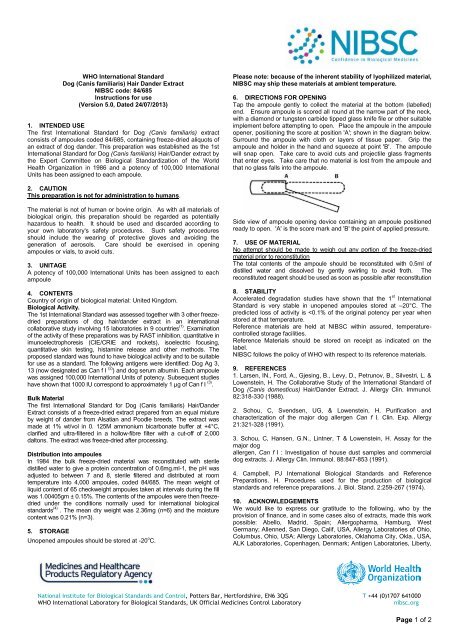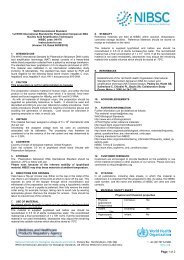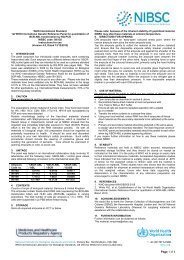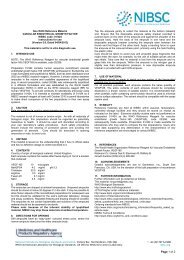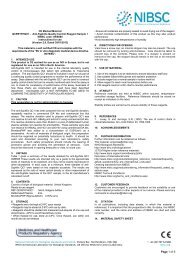Dog (Canis familiaris) Hair Dander Extract - NIBSC
Dog (Canis familiaris) Hair Dander Extract - NIBSC
Dog (Canis familiaris) Hair Dander Extract - NIBSC
Create successful ePaper yourself
Turn your PDF publications into a flip-book with our unique Google optimized e-Paper software.
WHO International Standard<br />
<strong>Dog</strong> (<strong>Canis</strong> <strong>familiaris</strong>) <strong>Hair</strong> <strong>Dander</strong> <strong>Extract</strong><br />
<strong>NIBSC</strong> code: 84/685<br />
Instructions for use<br />
(Version 5.0, Dated 24/07/2013)<br />
1. INTENDED USE<br />
The first International Standard for <strong>Dog</strong> (<strong>Canis</strong> <strong>familiaris</strong>) extract<br />
consists of ampoules coded 84/685, containing freeze-dried aliquots of<br />
an extract of dog dander. This preparation was established as the 1st<br />
International Standard for <strong>Dog</strong> (<strong>Canis</strong> <strong>familiaris</strong>) <strong>Hair</strong>/<strong>Dander</strong> extract by<br />
the Expert Committee on Biological Standardization of the World<br />
Health Organization in 1986 and a potency of 100,000 International<br />
Units has been assigned to each ampoule.<br />
Please note: because of the inherent stability of lyophilized material,<br />
<strong>NIBSC</strong> may ship these materials at ambient temperature.<br />
6. DIRECTIONS FOR OPENING<br />
Tap the ampoule gently to collect the material at the bottom (labelled)<br />
end. Ensure ampoule is scored all round at the narrow part of the neck,<br />
with a diamond or tungsten carbide tipped glass knife file or other suitable<br />
implement before attempting to open. Place the ampoule in the ampoule<br />
opener, positioning the score at position 'A'; shown in the diagram below.<br />
Surround the ampoule with cloth or layers of tissue paper. Grip the<br />
ampoule and holder in the hand and squeeze at point 'B'. The ampoule<br />
will snap open. Take care to avoid cuts and projectile glass fragments<br />
that enter eyes. Take care that no material is lost from the ampoule and<br />
that no glass falls into the ampoule.<br />
2. CAUTION<br />
This preparation is not for administration to humans.<br />
The material is not of human or bovine origin. As with all materials of<br />
biological origin, this preparation should be regarded as potentially<br />
hazardous to health. It should be used and discarded according to<br />
your own laboratory's safety procedures. Such safety procedures<br />
should include the wearing of protective gloves and avoiding the<br />
generation of aerosols. Care should be exercised in opening<br />
ampoules or vials, to avoid cuts.<br />
3. UNITAGE<br />
A potency of 100,000 International Units has been assigned to each<br />
ampoule<br />
4. CONTENTS<br />
Country of origin of biological material: United Kingdom.<br />
Biological Activity.<br />
The 1st International Standard was assessed together with 3 other freezedried<br />
preparations of dog hair/dander extract in an international<br />
collaborative study involving 15 laboratories in 9 countries (1) . Examination<br />
of the activity of these preparations was by RAST inhibition, quantitative in<br />
imunoelectrophoresis (CIE/CRIE and rockets), isoelectric focusing,<br />
quantitative skin testing, histamine release and other methods. The<br />
proposed standard was found to have biological activity and to be suitable<br />
for use as a standard. The following antigens were identified: <strong>Dog</strong> Ag 3,<br />
13 (now designated as Can f I (2) ) and dog serum albumin. Each ampoule<br />
was assigned 100,000 International Units of potency. Subsequent studies<br />
have shown that 1000 IU correspond to approximately 1 µg of Can f I (3) .<br />
Bulk Material<br />
The first International Standard for <strong>Dog</strong> (<strong>Canis</strong> <strong>familiaris</strong>) <strong>Hair</strong>/<strong>Dander</strong><br />
<strong>Extract</strong> consists of a freeze-dried extract prepared from an equal mixture<br />
by weight of dander from Alsatian and Poodle breeds. The extract was<br />
made at 1% wt/vol in 0. 125M ammonium bicarbonate buffer at +4°C,<br />
clarified and ultra-filtered in a hollow-fibre filter with a cut-off of 2,000<br />
daltons. The extract was freeze-dried after processing.<br />
Distribution into ampoules<br />
In 1984 the bulk freeze-dried material was reconstituted with sterile<br />
distilled water to give a protein concentration of 0.6mg.ml-1, the pH was<br />
adjusted to between 7 and 8, sterile filtered and distributed at room<br />
temperature into 4,000 ampoules, coded 84/685. The mean weight of<br />
liquid content of 65 checkweight ampoules taken at intervals during the fill<br />
was 1.00405gm ± 0.15%. The contents of the ampoules were then freezedried<br />
under the conditions normally used for international biological<br />
standards (4) . The mean dry weight was 2.36mg (n=6) and the moisture<br />
content was 0.21% (n=3).<br />
5. STORAGE<br />
Unopened ampoules should be stored at -20 o C.<br />
Side view of ampoule opening device containing an ampoule positioned<br />
ready to open. 'A' is the score mark and 'B' the point of applied pressure.<br />
7. USE OF MATERIAL<br />
No attempt should be made to weigh out any portion of the freeze-dried<br />
material prior to reconstitution<br />
The total contents of the ampoule should be reconstituted with 0.5ml of<br />
distilled water and dissolved by gently swirling to avoid froth. The<br />
reconstituted reagent should be used as soon as possible after reconstitution<br />
8. STABILITY<br />
Accelerated degradation studies have shown that the 1 st International<br />
Standard is very stable in unopened ampoules stored at –20°C. The<br />
predicted loss of activity is
Mo., USA, Beecham, Betchworth, Surrey, UK; Berkeley Biologicals,<br />
Berkeley, CaR, USA; Center Laboratories, Port Washington, N.Y.,<br />
USA; Diephuis Pharmacia, Groningen, The Netherlands; Greer<br />
Laboratories; Lenoir, N.C., USA, HAL Allergen Laboratories, Haarlem,<br />
The Netherlands; Hollister-Stier, Spokane, Wash., USA,. Laboratories<br />
Hamon, Montreal, Canada; Lofarma, Milano, Italy; Meridian Bio-<br />
Medical, Denver, Colo., USA, NYCO, Oslo, Norway; Omega<br />
Laboratories, Montreal, Canada; Pharmacia, Uppsala, Sweden and<br />
Stallergenes Laboratories, Pads, France<br />
11. FURTHER INFORMATION<br />
Further information can be obtained as follows;<br />
This material: enquiries@nibsc.org<br />
WHO Biological Standards:<br />
http://www.who.int/biologicals/en/<br />
JCTLM Higher order reference materials:<br />
http://www.bipm.org/en/committees/jc/jctlm/<br />
Derivation of International Units:<br />
http://www.nibsc.org/products/biological_reference_materials/frequentl<br />
y_asked_questions/how_are_international_units.aspx<br />
Ordering standards from <strong>NIBSC</strong>:<br />
http://www.nibsc.org/products/ordering_information/frequently_asked_<br />
questions.aspx<br />
<strong>NIBSC</strong> Terms & Conditions:<br />
http://www.nibsc.org/terms_and_conditions.aspx<br />
12. CUSTOMER FEEDBACK<br />
Customers are encouraged to provide feedback on the suitability or<br />
use of the material provided or other aspects of our service. Please<br />
send any comments to enquiries@nibsc.org<br />
13. CITATION<br />
In all publications, including data sheets, in which this material is<br />
referenced, it is important that the preparation's title, its status, the<br />
<strong>NIBSC</strong> code number, and the name and address of <strong>NIBSC</strong> are cited<br />
and cited correctly.<br />
14. MATERIAL SAFETY SHEET<br />
Physical and Chemical properties<br />
Physical appearance: Corrosive: No<br />
Freeze-dried powder<br />
Stable: Yes Oxidising: No<br />
Hygroscopic: No Irritant: No<br />
Flammable: No Handling: See caution, Section 2<br />
Other (specify): Contains material of biological origin<br />
Toxicological properties<br />
Effects of inhalation: Not established, avoid inhalation<br />
Effects of ingestion: Not established, avoid ingestion<br />
Effects of skin absorption: Not established, avoid contact with<br />
skin<br />
Suggested First Aid<br />
Inhalation: Seek medical advice<br />
Ingestion: Seek medical advice<br />
Contact with eyes: Wash with copious amounts of water. Seek<br />
medical advice<br />
Contact with skin: Wash thoroughly with water.<br />
Action on Spillage and Method of Disposal<br />
Spillage of ampoule contents should be taken up with absorbent<br />
material wetted with an appropriate disinfectant. Rinse area with an<br />
appropriate disinfectant followed by water.<br />
Absorbent materials used to treat spillage should be treated as<br />
biological waste.<br />
15. LIABILITY AND LOSS<br />
Information provided by the Institute is given after the exercise of all<br />
reasonable care and skill in its compilation, preparation and issue, but it<br />
is provided without liability to the Recipient in its application and use.<br />
It is the responsibility of the Recipient to determine the appropriateness of<br />
the standards or reference materials supplied by the Institute to the<br />
Recipient (“the Goods”) for the proposed application and ensure that it<br />
has the necessary technical skills to determine that they are appropriate.<br />
Results obtained from the Goods are likely to be dependent on conditions<br />
of use by the Recipient and the variability of materials beyond the control<br />
of the Institute.<br />
All warranties are excluded to the fullest extent permitted by law,<br />
including without limitation that the Goods are free from infectious agents<br />
or that the supply of Goods will not infringe any rights of any third party.<br />
The Institute shall not be liable to the Recipient for any economic loss<br />
whether direct or indirect, which arise in connection with this agreement.<br />
The total liability of the Institute in connection with this agreement,<br />
whether for negligence or breach of contract or otherwise, shall in no<br />
event exceed 120% of any price paid or payable by the Recipient for the<br />
supply of the Goods.<br />
If any of the Goods supplied by the Institute should prove not to meet<br />
their specification when stored and used correctly (and provided that the<br />
Recipient has returned the Goods to the Institute together with written<br />
notification of such alleged defect within seven days of the time when the<br />
Recipient discovers or ought to have discovered the defect), the Institute<br />
shall either replace the Goods or, at its sole option, refund the handling<br />
charge provided that performance of either one of the above options shall<br />
constitute an entire discharge of the Institute’s liability under this<br />
Condition.<br />
16. INFORMATION FOR CUSTOMS USE ONLY<br />
Country of origin for customs purposes*: United Kingdom<br />
* Defined as the country where the goods have been produced and/or<br />
sufficiently processed to be classed as originating from the country of<br />
supply, for example a change of state such as freeze-drying.<br />
Net weight: 0.01g<br />
Toxicity Statement: Non-toxic<br />
Veterinary certificate or other statement if applicable.<br />
Attached: No<br />
National Institute for Biological Standards and Control, Potters Bar, Hertfordshire, EN6 3QG T +44 (0)1707 641000<br />
WHO International Laboratory for Biological Standards, UK Official Medicines Control Laboratory<br />
nibsc.org<br />
Page 2 of 2


